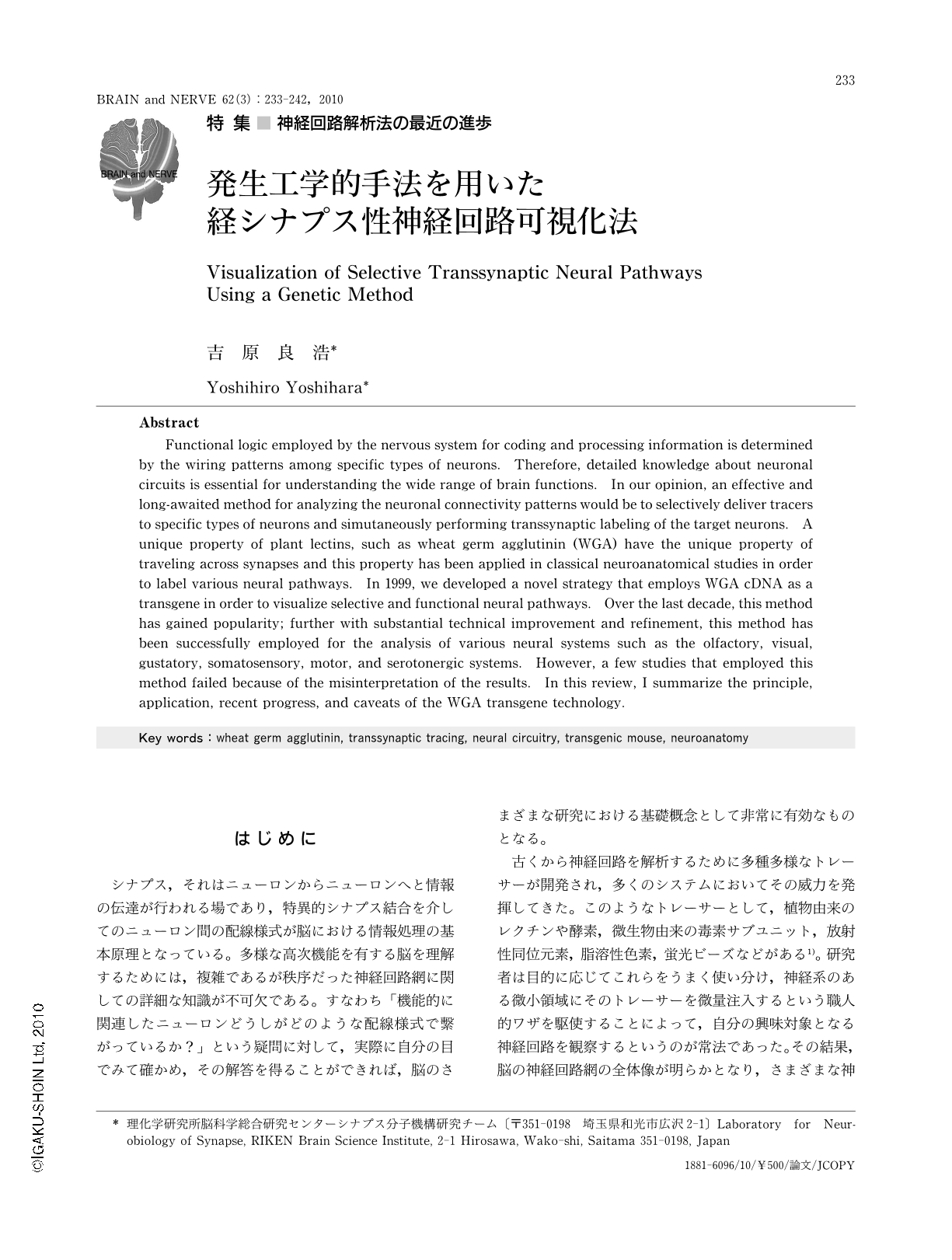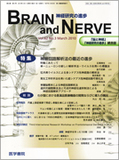Japanese
English
- 有料閲覧
- Abstract 文献概要
- 1ページ目 Look Inside
- 参考文献 Reference
はじめに
シナプス,それはニューロンからニューロンへと情報の伝達が行われる場であり,特異的シナプス結合を介してのニューロン間の配線様式が脳における情報処理の基本原理となっている。多様な高次機能を有する脳を理解するためには,複雑であるが秩序だった神経回路網に関しての詳細な知識が不可欠である。すなわち「機能的に関連したニューロンどうしがどのような配線様式で繋がっているか?」という疑問に対して,実際に自分の目でみて確かめ,その解答を得ることができれば,脳のさまざまな研究における基礎概念として非常に有効なものとなる。
古くから神経回路を解析するために多種多様なトレーサーが開発され,多くのシステムにおいてその威力を発揮してきた。このようなトレーサーとして,植物由来のレクチンや酵素,微生物由来の毒素サブユニット,放射性同位元素,脂溶性色素,蛍光ビーズなどがある1)。研究者は目的に応じてこれらをうまく使い分け,神経系のある微小領域にそのトレーサーを微量注入するという職人的ワザを駆使することによって,自分の興味対象となる神経回路を観察するというのが常法であった。その結果,脳の神経回路網の全体像が明らかとなり,さまざまな神経システムにおいて多くの知見が得られ,脳科学の発展に多大な貢献がなされた。しかしながら,このような方法には次のような問題点が常に付きまとっていた。
1)注入部位近傍のすべての細胞へのトレーサーの取り込みが起こり,その部位を起点とする多くの神経回路が同時にラベルされてしまう。すなわち,特定のタイプの神経細胞からの機能的神経回路を選択的に可視化することは不可能である。
2)トレーサー注入を受けた動物がそれを異物として認識し,重篤な免疫・炎症反応を起こすことがある。
3)トレーサーを同じ部位に正確に注入するためには熟練した技術が必要であり,再現性・信頼性のある実験データを得るのが比較的困難である。
以上のような問題点を克服するために,1999年,筆者らは小麦胚芽レクチン(wheat germ agglutinin:WGA)遺伝子をトランスジーンとして用いることにより,神経回路を機能別に選択的に可視化する新技術を開発した2,3)。特異的プロモーターの制御下に特定のタイプのニューロンで産生されたWGAは,シナプスを介して2次ニューロンへ,さらには3次ニューロンへまで輸送され,特定の神経回路を選択的にラベルすることが可能となった。その後,筆者らを含む多くの研究者たちによってこの方法はさらに洗練され,さまざまな神経システムで選択的神経回路の可視化に有効利用されてきた。しかしながら,この方法を利用した実験結果を誤って解釈し,混乱をもたらした数編の論文も発表されている。本総説では,WGAトランスジーン技術の原理,応用,最近の成果を詳細に解説する。また本技術の開発者としてのさまざまな経験から,今後WGAトランスジーン技術の利用を試みる研究者たちに,決して落とし穴に陥らないために適正かつ慎重な実験を行うよう警鐘を鳴らしたい。
Abstract
Functional logic employed by the nervous system for coding and processing information is determined by the wiring patterns among specific types of neurons. Therefore,detailed knowledge about neuronal circuits is essential for understanding the wide range of brain functions. In our opinion,an effective and long-awaited method for analyzing the neuronal connectivity patterns would be to selectively deliver tracers to specific types of neurons and simutaneously performing transsynaptic labeling of the target neurons. A unique property of plant lectins,such as wheat germ agglutinin (WGA) have the unique property of traveling across synapses and this property has been applied in classical neuroanatomical studies in order to label various neural pathways. In 1999,we developed a novel strategy that employs WGA cDNA as a transgene in order to visualize selective and functional neural pathways. Over the last decade,this method has gained popularity; further with substantial technical improvement and refinement,this method has been successfully employed for the analysis of various neural systems such as the olfactory,visual,gustatory,somatosensory,motor,and serotonergic systems. However,a few studies that employed this method failed because of the misinterpretation of the results. In this review,I summarize the principle,application,recent progress,and caveats of the WGA transgene technology.

Copyright © 2010, Igaku-Shoin Ltd. All rights reserved.


